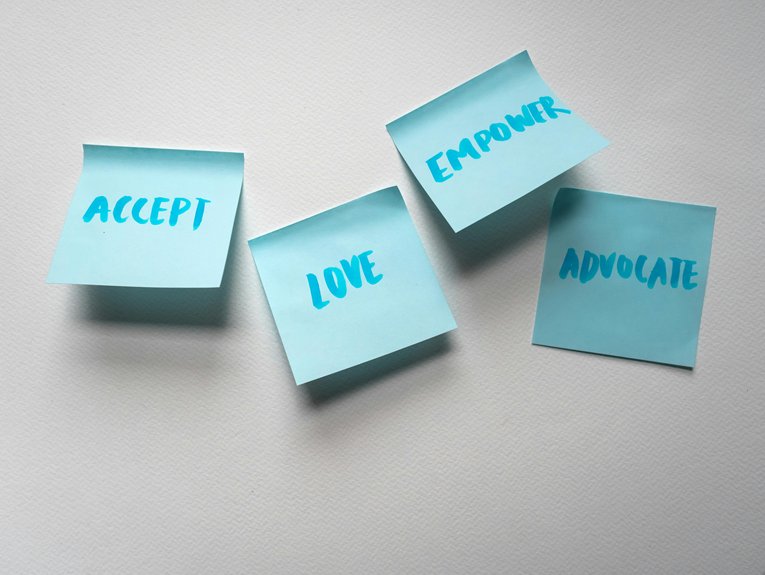Fear shows up at the worst moments. That “I might throw up” feeling before a job interview. The sweaty panic when you’re about to give a speech. The absolute dread as you climb into that roller coaster your friends pressured you into riding (thanks a lot, guys).
Your brain becomes a master of excuses**** – offering approximately 47 reasons why you should run away immediately. Been there? Yeah, we thought so.
Good news: you don’t need fancy techniques or complicated strategies. Just a few powerful phrases can transform that paralyzing terror into something more like “okay, I’ve got this.”
These affirmations aren’t magical fixes or mind-control mantras. They’re more like mental armor – simple but effective tools to help you push through when everything inside screams “NOPE.”
Key Takeaways
- Effective affirmations remind you of past successes and build self-trust when facing intimidating situations.
- Reframing physical fear symptoms as excitement helps manage anxiety before challenging events.
- Personalized affirmations that emphasize your unique strengths create more powerful psychological responses.
- Using mantras that acknowledge fear while affirming capability encourages action despite discomfort.
- Pairing affirmations with deep breathing techniques calms your nervous system during scary situations.
I am capable of handling whatever comes my way.
This affirmation builds your trust in yourself to manage unexpected challenges, setbacks, and obstacles—even when facing something that frightens you.
To truly embrace this affirmation, start by reflecting on past victories. Remember that time you were sure you’d fail but somehow pulled through? Or when something went sideways, and you figured it out anyway? Those weren’t flukes—they were evidence of your resilience. Our brains love focusing on what might go wrong while conveniently forgetting all the times we’ve overcome difficulties.
Stepping outside comfort zones often leads to personal growth and increased confidence, even when it feels uncomfortable at first.
Take a moment each day to consciously remind yourself: “I’ve handled tough situations before, and I can handle this too.”
The second step involves reframing “failures” as data points rather than catastrophes. When attempting something scary, perfectionism becomes your worst enemy—it paralyzes you with unrealistic expectations. Instead, adopt what psychologists call a “growth mindset.”
Think of yourself as a scientist running experiments: some work, some don’t, but all provide valuable information. That presentation that went sideways last month? Not a personal defect—just valuable feedback on what to adjust next time.
Your capacity to handle challenges expands when you see setbacks as temporary and instructive rather than permanent and defining.
The final piece involves physical preparation for scary moments. Your body doesn’t know the difference between excitement and fear—both involve racing hearts and sweaty palms. The trick is channeling that energy productively.
When facing something challenging, take three deep breaths while silently repeating this affirmation. This triggers your parasympathetic nervous system, quieting the “fight or flight” response that clouds thinking. Your body calms down enough for your brain to remember: “Oh right, I actually do know how to handle this.” It sounds almost comically simple, but this physical reset can change panic into productive energy.
- Create a “Victory Log”: Keep a running list of challenges you’ve overcome, big and small. Review it before tackling something scary to remind yourself of your proven track record.
- Practice strategic discomfort: Regularly do small things outside your comfort zone (cold showers, talking to strangers, trying new foods). These build your “discomfort muscle” for bigger challenges.
- Develop contingency plans: Before doing something scary, ask “What’s the worst that could happen?” then make a simple plan for each scenario. This removes the vague dread of the unknown.
- Use physical anchors: Touch your thumb and forefinger together while saying this affirmation. Eventually, this simple gesture can trigger confidence even when you’re too nervous to remember the words.
Fear is temporary; I am stronger than this moment.
When panic seizes your body and your mind races with worst-case scenarios, remember that fear, no matter how overwhelming it feels in the moment, is simply a temporary visitor—not a permanent resident. Your nervous system is designed to protect you, but sometimes it overreacts to perceived threats, flooding your body with adrenaline and cortisol that trigger the fight-or-flight response. You’re building resilience every time you face your fears head-on instead of running away, creating new neural pathways that strengthen your ability to cope with future challenges. Trust your intuition; it’s often smarter than your anxious thoughts, drawing from a deep well of experience and wisdom that your conscious mind might overlook. Life’s valuable lessons emerge only when we summon the courage to confront our deepest fears.
| Facing Fear | What It Feels Like | What It Actually Is |
|---|---|---|
| First attempt | Heart-pounding terror, shallow breathing, tunnel vision | Developing courage, activating natural stress response, building neural pathways |
| Second try | Sweaty palms, doubt, racing thoughts, muscle tension | Challenging limits, rewiring fear response, strengthening self-trust |
| Third effort | Slight nervousness, butterflies in stomach, heightened awareness | Finding strength, establishing new comfort zones, developing mastery |
| Fourth go | Manageable discomfort, increased focus, steady breathing | Embracing vulnerability, integrating past experiences, cultivating resilience |
| Final push | Quiet confidence, centered awareness, calm determination | Overcoming anxiety, embodying growth, achieving transformation |
Accepting discomfort doesn’t mean you’re failing—it means you’re growing. The most courageous people aren’t fearless; they’re just better at redefining failure as feedback.
The journey through fear transformation is a profound process of self-discovery and personal evolution. Each time you choose to stay present with difficult emotions rather than avoid them, you’re strengthening your emotional intelligence and expanding your capacity for handling life’s challenges. The path to authentic courage isn’t about eliminating fear but about developing a new relationship with it, understanding that discomfort is often the prerequisite for meaningful change and personal growth. Your brain’s neuroplasticity ensures that every brave choice you make literally reshapes your neural pathways, making future acts of courage more accessible and natural.
This challenge will help me grow and become better.
When you affirm that a scary challenge will help you grow, you’re acknowledging that discomfort is in fact your personal development gym membership, paid in full with your courage.
Embracing this affirmation starts with reframing what “scary” means to you. Instead of seeing that presentation, difficult conversation, or new venture as a threat, visualize it as a growth opportunity with your name written all over it.
Remember the last time you did something terrifying? That awkward, palm-sweating moment probably taught you something valuable that you still carry today. The difference between staying stagnant and evolving is often merely five seconds of bravery followed by action.
The growth mindset isn’t only motivational poster material—it’s backed by science. Your brain physically reshapes itself when faced with challenges, forming new neural pathways that make you smarter and more capable.
That promotion you’re hesitating to apply for? It’s fundamentally a personal trainer for your professional development. That uncomfortable conversation you’ve been avoiding? It’s emotional intelligence boot camp.
When you whisper to yourself, “This challenge will help me grow,” you’re not merely being optimistic—you’re being neurologically accurate.
The beauty of this affirmation lies in its aftermath. After conquering something scary, you’ll notice subtle shifts in your confidence.
Tasks that once seemed impossible gradually become part of your “been there, done that” collection. Each scary thing you tackle actually calibrates your fear meter, so what terrified you last year might merely make you nervous today. Talk about a tangible return on investment!
When you recognize the signs of readiness for growth, every challenge becomes an opportunity to expand your comfort zone.
- Journal the growth: After facing something frightening, document exactly what you learned and how it changed you—this creates concrete evidence of your evolution that you can reference when tackling the next scary thing.
- Identify the specific muscles being strengthened: Whether it’s resilience, communication skills, or technical knowledge, naming exactly how this challenge will improve you makes the growth more tangible and motivating.
- Create a “Growth Through Fear” inventory: Maintain a running list of scary things you’ve already conquered and what each experience taught you—concrete proof that fear has been your unexpected mentor all along.
- Partner with a growth accountability buddy: Share your scary challenge with someone who can check in on your progress and remind you of the growth potential when your courage starts wavering.
I’ve faced difficulties before, and I can do it again.
Your personal history of overcoming challenges is perhaps the most powerful evidence of resilience you’ll ever possess, serving as a testament to your inner strength and determination. Think about it—you’ve already survived 100% of your worst days, proving your capacity for endurance through every single trial you’ve encountered. When embracing fear seems impossible, remember your past victories and the wisdom gained from each experience. You’ve built emotional fortitude through every challenge you’ve faced, creating a foundation of strength that continues to support your growth.
| Challenge Type | What It Built In You |
|---|---|
| Personal setbacks | Inner strength, self-awareness, emotional intelligence |
| Professional obstacles | Self-empowerment, strategic thinking, leadership skills |
| Relationship difficulties | Emotional resilience, communication abilities, boundary-setting |
| Health struggles | Mental toughness, patience, body awareness |
| Financial problems | Adaptability, resourcefulness, money management skills |
Look, reformative journeys aren’t always pretty, but they’re always worth it. Next time you’re sweating bullets before doing something scary, remind yourself: “This isn’t my first rodeo with discomfort.”
Your track record of overcoming adversity isn’t just impressive—it’s proof you’ve got what it takes to face whatever comes next. Through each challenge, you’ve developed a unique set of coping mechanisms and problem-solving strategies that serve as your personal toolkit for future obstacles.
The process of overcoming difficulties has equipped you with invaluable personal wisdom that cannot be learned from books or borrowed from others. Each triumph over adversity has contributed to your expanding reservoir of strength, making you more capable and resilient with every challenge you face.
Staying in your comfort zone limits your potential for personal growth and meaningful achievements in life.
I trust myself and my ability to succeed.
Trusting yourself means recognizing your inherent capacity to handle challenges, even when your knees are wobbling and your stomach feels like it’s hosting Olympic gymnastics trials.
Building self-trust doesn’t happen overnight—it grows like that weird plant in your kitchen window that somehow survives despite your questionable nurturing skills. Start by acknowledging your past victories, no matter how small. Remember that time you finally made a doctor’s appointment after putting it off for months? Or when you spoke up in that intimidating meeting? Those moments matter.
Write them down somewhere visible, creating evidence of your capability that even your anxious brain can’t argue with. These reminders become especially valuable when you’re facing something that makes your heart race and palms sweat.
The beautiful thing about self-trust is that it compounds interest like the world’s most reliable investment. Each time you do something scary—and survive—you add to your trust fund. Maybe you’re terrified of public speaking but agreed to give that presentation anyway. Regardless of how it went (perfect delivery or total word-salad), you showed up. That courage deserves recognition.
When facing your next scary challenge, remind yourself: “I’ve done hard things before. I survived them. I can do this too.” This isn’t empty positive thinking; it’s acknowledging your proven resilience and capacity to grow through discomfort.
Embracing daily challenges helps build the resilience needed to face bigger fears head-on.
Practicing self-trust works best when facing intimidating situations because that’s where it matters most. Consider these practical approaches to strengthen your belief in yourself:
- Create a “Victory Log” documenting times you’ve overcome obstacles—review it before attempting something that scares you to remind yourself of your proven track record.
- Replace “What if I fail?” thinking with “What if I succeed?” visualization, spending five minutes daily imagining yourself handling the scary situation competently.
- Adopt a personal mantra tied to your specific strengths, such as “My creativity finds solutions” or “My persistence outlasts problems.”
- Break intimidating challenges into smaller steps and celebrate completing each one—this creates evidence of your capability while building momentum toward the scarier parts.
Every step forward is progress, no matter how small.
In the face of terrifying challenges, we often overlook the humble power of small steps and their cumulative impact on personal growth. When confronted with overwhelming obstacles, our minds tend to seek grand solutions, yet it’s the consistent micro-actions that truly drive lasting change and meaningful progress. You don’t need to conquer mountains in a single bound—your Growth Journey is built on Mindful Steps that accumulate over time. The beauty of incremental progress lies in its sustainability and ability to create permanent behavioral change through manageable actions. Taking on a 30-day growth challenge can provide the perfect structure to build momentum through daily action.
| Small Victories | Why They Matter |
|---|---|
| Sending that email | Builds Positive Momentum by overcoming initial resistance and creating forward motion |
| Making one phone call | Develops Progress Mindset through confronting communication anxiety and building confidence |
| Asking one question | Promotes Incremental Growth by fostering curiosity and expanding knowledge boundaries |
| Showing up scared | Requires Self Compassion while building resilience through conscious vulnerability |
| Taking the first step | Creates Action Momentum by breaking through initial paralysis |
| Completing minor tasks | Establishes Success Patterns that reinforce positive behaviors |
Don’t wait until you feel 100% ready—you’ll be waiting forever. The pursuit of perfection often serves as a barrier to meaningful action and personal development. Instead, track your Daily Progress and Celebrate Achievements, no matter how insignificant they seem. Your commitment to documentation creates a powerful record of growth that sustains motivation.
The power of Incremental Progress lies in its ability to bypass our natural resistance to change and create sustainable transformation. Each small victory rewires our neural pathways, building new patterns of behavior that become increasingly automatic over time. Your Personal Milestones aren’t measured against others but against where you started. The most meaningful growth occurs when we focus on our individual journey rather than external comparisons.
My courage is greater than my fear.
This affirmation reminds you that while fear exists, your inner strength and bravery have more power than whatever scares you.
Embracing this affirmation starts with acknowledging both sides of the equation – yes, you’re afraid, and yes, you possess courage. When you’re staring down something terrifying, whether it’s a job interview, skydiving, or telling someone how you really feel, your brain loves to spotlight all the potential disasters while keeping your courage in the shadows.
But courage isn’t the absence of fear; it’s the muscle that pushes through despite it. Try placing your hand on your heart while saying, “My courage is greater than my fear,” and visualize your bravery expanding like a balloon inside your chest, gradually pushing the fear to make room for itself.
The magic happens when you start collecting evidence that proves this affirmation true. Think back to that time you were terrified but did the scary thing anyway – that presentation you survived, the difficult conversation you initiated, or even the rollercoaster you rode despite your knees knocking. Those weren’t flukes; they were your courage flexing its muscles.
Each time you choose action despite fear, you’re fundamentally telling your brain, “See? The affirmation is correct.” Your nervous system starts to catch on, and gradually, the statement feels less like a hopeful phrase and more like an observable fact about who you are.
What makes this affirmation particularly powerful is that it doesn’t ask you to eliminate fear (which would be weird and probably impossible). Instead, it creates a relationship of proportion – your fear can exist AND your courage can be bigger.
On mornings when you wake up with your stomach in knots about something scary ahead, repeating “My courage is greater than my fear” isn’t focused on talking yourself out of being nervous; it’s centered on reminding yourself that you come equipped with something stronger. Your fear might be shouting, but your courage has a louder voice if you choose to amplify it.
Understanding how to embrace risk intelligently allows you to transform challenging situations into opportunities for growth.
- Create a “courage evidence journal” where you document every instance when you did something despite being afraid, no matter how small – each entry reinforces the truth of this affirmation.
- Practice physically embodying courage when saying this affirmation – stand tall with shoulders back and chin slightly raised rather than hunched over, as your body posture influences how your mind processes the words.
- Pair this affirmation with deep breathing – inhale for 4 counts (“my courage”), hold for 2, and exhale for 6 (“is greater than my fear”) to engage your parasympathetic nervous system while reinforcing the message.
- Customize the affirmation to address specific fears: “My courage is greater than my fear of rejection” or “My courage is greater than my fear of failure” to make it more targeted and personally meaningful.
I’m ready to take this leap and embrace the unknown.
When you declare “I’m ready to take this leap and embrace the unknown,” you’re fundamentally serving yourself an enormous slice of courage cake that nourishes your spirit and strengthens your resolve. This powerful affirmation isn’t just words floating in the air—it’s your battle cry against the comfort zone that’s been holding you hostage, a declaration that marks the moment you choose growth over stagnation.
| Embracing Uncertainty Means | And Leads To |
|---|---|
| Facing fears head-on with unwavering determination | Self discovery journey through personal challenges and triumphs |
| Taking calculated risks despite butterflies and doubt | Building resilience through repeated exposure to challenges |
| Trusting intuition when logic screams “no” and others hesitate | Expanding comfort zones into new territories of possibility |
| Cultivating bravery through consistent, deliberate action | Seeking daily growth opportunities in career and life |
| Embracing failure as a teacher and stepping stone | Developing emotional intelligence and adaptability |
| Challenging personal limiting beliefs daily | Creating lasting positive change and momentum |
Look, everyone hits barriers that seem insurmountable, those moments when the path forward appears blocked by mountains of doubt and uncertainty. The difference between those who break through and those who retreat lies in a fundamental willingness to leap anyway, even when success isn’t guaranteed.
The journey into the unknown isn’t just about the destination—it’s about who you become along the way through intentional growth and conscious challenge. Every step outside your comfort zone rewires your brain for courage, building neural pathways that make future leaps less daunting and more exciting. Your palms might sweat and your heart might race, but that’s just your body catching up to where your mind already is: on the edge of something incredible, poised for transformation. Breaking free from comfort requires consistent practice and a willingness to challenge yourself daily.
I’ve prepared for this moment, and I’m ready.
This affirmation acknowledges the preparation you’ve put in and declares your readiness to face whatever scary situation lies ahead.
Embracing this affirmation starts with actually doing the preparation work, then recognizing it. Take inventory of everything you’ve done to get ready—the research, the practice runs, the conversations with others who’ve been there.
Remember that time you spent Googling “how not to faint during public speaking” at 2 AM? Or when you made your friend listen to your presentation five times? Yeah, that counts as preparation. Your brain needs reminding of these efforts because fear has a sneaky way of making you forget how capable you actually are.
The magic happens when you connect your preparation to your current state of readiness. Instead of thinking, “I hope I don’t mess up,” shift to, “I’ve practiced this speech twelve times and know it by heart.”
Rather than “What if I freeze?” try, “I’ve researched every possible question and have thoughtful answers ready.” This doesn’t concern delusional positivity—it’s about accurately evaluating your situation. You wouldn’t show up to run a marathon without training, and you haven’t shown up to this scary moment without preparation either.
The beauty of this affirmation is that it works both as a confirmation and as a gentle nudge. If you truly have prepared, it validates your efforts. If you haven’t prepared enough, it serves as motivation to take those necessary steps before facing your fear.
Either way, it changes nebulous anxiety into practical action. When you find yourself spiraling with “what-ifs,” interrupt that cycle by focusing on the concrete steps you’ve taken. Your preparation isn’t just busywork—it’s your evidence that you can handle what’s coming. By confronting your self-imposed limits head-on through preparation, you create space for genuine growth and achievement.
- Create a “preparation inventory” – Write down every single thing you’ve done to prepare, no matter how small. Seeing it all listed out provides concrete evidence that you’re more ready than you feel.
- Visualize your preparation in action – Mentally rehearse how your preparation will help you navigate specific challenges. “If X happens, I’ll use Y skill that I’ve practiced.”
- Attach this affirmation to physical anchors – Choose an object (a bracelet, a stone in your pocket) or a gesture (squaring your shoulders) that triggers your memory of preparation and readiness.
- Turn preparation into a ritual – Develop a consistent pre-challenge routine that signals to your brain it’s game time. The familiarity of the routine itself becomes another form of preparation you can rely on.
The discomfort I feel now is a sign of growth.
Feeling uncomfortable as you step into the scary unknown isn’t just normal—it’s actually a powerful indicator that you’re expanding beyond your comfort zone. That flutter in your stomach is your growth mindset kicking into gear, activating neural pathways that signal transformation and development. When you’re embracing discomfort, you’re literally reshaping your brain for resilience building through a process called neuroplasticity. Your brain forms new connections and strengthens existing ones as you push through challenges and face uncertainty.
| When You Feel This | Remember This |
|---|---|
| Sweaty palms | Your body’s preparing for success by releasing performance-enhancing hormones |
| Racing thoughts | Your mind’s stretching its abilities and creating new neural pathways |
| Urge to retreat | You’re at the edge of change where breakthrough moments happen |
| Self-doubt | This is where confidence grows through repeated exposure and small wins |
| Physical tension | You’re strengthening your fear management muscles and building emotional resilience |
| Butterflies | Your body is mobilizing energy for peak performance |
| Mental fog | Your brain is reorganizing to accommodate new patterns of thinking |
Look, nobody discovers their true potential while Netflix-and-chilling. Stepping outside what feels safe is exactly how personal change happens, as each challenge creates an opportunity for adaptive growth. That discomfort you’re feeling? It’s just growing pains on your journey to becoming your badass self, marking the transformation of your comfort zone’s boundaries.
Understanding the science behind productive discomfort can revolutionize how you approach challenges and personal development. Every time you lean into uncertainty, you’re actively participating in your own evolution, strengthening your psychological immunity through deliberate exposure to growth opportunities. The temporary unease you experience today is building the foundation for tomorrow’s achievements, creating a more resilient and capable version of yourself through each conscious step forward. Personal breakthroughs often emerge when we consistently practice uncomfortable habits.
I am not defined by my fear; I am defined by my actions.
This affirmation reminds us that while fear might live in our minds rent-free, it’s what we actually do that shapes our identity and life story.
When facing something scary, our brains love to convince us that our fears represent who we are. “I’m just an anxious person,” we tell ourselves, or “I’ve always been afraid of public speaking.” But that’s giving fear way too much power.
Think about it: if you’re afraid of heights but climb that mountain anyway, which matters more—the knot in your stomach or the fact that you made it to the summit? Your actions spoke volumes while your fear just whispered nonsense in your ear. The truth is, courage isn’t the absence of fear; it’s acting despite it.
The beautiful thing about defining yourself through actions is that it puts you back in control. Fear happens to you, but actions come from you. When you’re staring down something terrifying—whether it’s asking someone out, starting a business, or finally learning to swim—remember that this moment won’t be recorded in your personal history as “that time I felt scared.”
It will be remembered as “that time I did the scary thing anyway.” Your fear is just weather passing through; your actions are the path you’re actively creating.
This mindset shift isn’t just motivational fluff—it’s practical psychology. When you separate your identity from your feelings and attach it instead to your behaviors, you create mental space to acknowledge the fear without being consumed by it.
Learning to embrace discomfort consistently can transform temporary courage into lasting psychological resilience.
“Yes, I’m nervous about this job interview, AND I’m showing up prepared.” Both can be true. The fear doesn’t disappear, but it gets demoted from defining characteristic to temporary passenger.
- Track your “despite fear” moments in a journal, noting what you did despite being afraid, to build concrete evidence that your actions define you more than your fears do.
- When introducing yourself (even just in your mind), practice identifying yourself by brave actions you’ve taken rather than fears you have: “I’m someone who tried rock climbing even though heights terrify me.”
- Create a physical reminder—a bracelet, phone background, or small object—that symbolizes a time when your actions spoke louder than your fear, and use it during scary situations.
- When fear tries to define you (“I’m too scared to do this”), linguistically separate it by saying, “A part of me feels scared, but that’s not all of me,” acknowledging the fear without giving it your whole identity.
I choose courage over fear every time.
Choice stands at the crossroads of every frightening situation, offering us two paths: retreat into the familiar comfort of fear or step forward into the growing pains of courage. When you decide to choose courage over fear, you’re not ignoring your anxiety—you’re acknowledging it and moving forward anyway, creating a foundation for personal transformation and growth. The process of fear confrontation requires both awareness and deliberate action, forcing us to face our deepest insecurities and limitations. This conscious decision to embrace discomfort becomes easier with practice, as each small victory builds upon the last to create lasting change. Transformational experiences often demand that we step into uncertainty with determination and resilience.
| When Fear Says | Courage Responds | Your Growth | Action Steps |
|---|---|---|---|
| “You’ll fail” | “Maybe, but I’ll learn and grow stronger from the experience” | Resilience & Adaptability | Document lessons from setbacks |
| “People will judge” | “Their opinions don’t define me, only my actions do” | Independence & Self-trust | Set personal boundaries |
| “It’s too hard” | “I can handle hard things and develop new capabilities” | Strength & Perseverance | Break tasks into smaller steps |
| “Play it safe” | “Growth lives outside comfort, and that’s where I need to be” | Expansion & Innovation | Take calculated risks daily |
| “You’re not ready” | “I’ll learn by doing and adjust as needed” | Confidence & Skill-building | Start before feeling fully prepared |
The journey of personal development through choosing courage creates rippling effects throughout all aspects of life, transforming not just our actions but our entire self-concept. This transformation occurs gradually through consistent brave choices, building a foundation of self-trust and resilience that becomes stronger with each challenge we face.
The best things in life require stepping out of my comfort zone.
The most meaningful achievements and profound experiences in life consistently happen when we push ourselves beyond the familiar boundaries of what feels safe and comfortable.
When you recognize that discomfort is actually the gateway to growth, everything changes. That promotion you’ve been eyeing? It demands you speak up in meetings when your heart’s racing. That relationship you want? It requires vulnerability that makes your stomach twist into knots. That adventure you’ve dreamed about? It’s waiting for you on the other side of that terrifying first step.
I’ve found that writing down daily affirmations like “I embrace challenges as opportunities” helps reprogram my brain to seek growth instead of comfort. The magic happens when you start celebrating the discomfort instead of running from it. Remember that time you were absolutely terrified to do something but did it anyway? How alive did you feel afterward?
That feeling—that’s your evidence. The universe rewards courage with experiences that comfortable choices never deliver. Next time you feel that familiar resistance, try saying aloud, “This fear means I’m about to grow,” and watch how that tiny shift in perspective makes the scary thing seem more like an adventure than a threat.
My favorite approach? Create a comfort zone exit strategy by breaking down the scary thing into smaller steps. For example, if public speaking terrifies you, start by recording yourself speaking, then practice with one trusted friend, then a small group, before tackling the big presentation. Your brain needs proof that you can survive these small exits before it will trust the big ones.
- Track your comfort zone exits: Keep a journal documenting each time you do something uncomfortable and the positive outcomes that followed—this creates evidence your brain can’t argue with.
- Adopt a “five seconds of courage” mindset: Often, the hardest part is starting; commit to just five seconds of bravery to initiate the scary action, and momentum will carry you forward.
- Partner with a “courage accountability buddy”: Share your comfort-zone-stretching goals with someone who’ll check in on your progress and celebrate your wins, no matter how small.
- Reframe “failure” as data collection: When stepping outside your comfort zone doesn’t go as planned, view it as valuable information gathering rather than a personal shortcoming—now you know more than you did before.
I am worthy of success, even if it feels scary.
Fear of success runs deeper than most of us care to admit, holding us back with whispers that we’re somehow not deserving of the very things we want most. These internal barriers often stem from deeply rooted childhood experiences and societal conditioning that make us question our abilities and worth. You’re programmed to doubt your worthiness, but that’s just your brain playing old, unhelpful tapes that no longer serve your growth. The key to overcoming this self-limiting mindset lies in recognizing these patterns and consciously choosing to rewrite your internal narrative.
| Success Mindset | Fear Management | Growth Strategy |
|---|---|---|
| “I deserve this” daily mirror work | Deep breathing exercises + meditation | Gradual exposure through small challenges |
| Positive affirmations + visualization | Name your fears in writing | Setting micro-goals with deadlines |
| Study role models + read biographies | Comfort zone mapping exercises | Celebrating small wins consistently |
| Self-worth journal + gratitude lists | “What’s the worst?” scenario planning | Tracking progress with metrics |
| Identity statements + core values | Fear-releasing rituals | Monthly milestone reviews |
Try this: when self-doubt creeps in, ask yourself what you’d tell your best friend facing the same situation. Isn’t it time you treated yourself with that same compassion?
Understanding and embracing your potential requires a fundamental shift in how you perceive personal achievement. This journey involves recognizing that success isn’t just about reaching external milestones, but about developing a deeper connection with your authentic self and your inherent worthiness. The process of building self-trust and confidence becomes easier when you approach it as a gradual evolution rather than an overnight transformation. Remember that every step forward, no matter how small, reinforces your capability and strengthens your belief in your ability to succeed.
I will feel proud of myself no matter the outcome.
Pride doesn’t just come from success—it comes from having the courage to attempt something that scares you, regardless of how things turn out in the end.
Detaching your self-worth from the outcome starts with reframing what “success” actually means. When you’re doing something scary, the victory isn’t in the perfect execution or ideal result—it’s in showing up despite your racing heart and sweaty palms. Think about it this way: if you’re terrified of public speaking but manage to stand up and deliver your presentation (even if you stumble over words or forget parts), you’ve already accomplished something remarkable. The audience‘s reaction matters less than the personal mountain you just climbed.
Building this mindset takes practice, especially in a world obsessed with visible achievement. Before you tackle that scary thing, take a moment to explicitly acknowledge what you’ll be proud of regardless of external validation.
Maybe it’s “I’ll be proud that I applied for that job even if I don’t get an interview” or “I’ll be proud I asked that question in the meeting even if my voice shook.” Write it down somewhere if that helps cement the commitment. When the moment passes, regardless of outcome, pause to actively recognize your courage—don’t brush it off as “no big deal” when it absolutely was a big deal to your nervous system.
Remember that growth happens most dramatically in moments of discomfort, not in our comfort zones. Each time you do something scary, you’re strengthening your courage muscles, expanding your capabilities, and proving to yourself that you can survive feared situations.
These benefits happen regardless of external outcomes. So that presentation where you forgot half your points? You still learned something valuable about managing nerves. That awkward first date where conversation lagged? You still practiced vulnerability. In the grand story of your life, these courageous attempts will shine more brightly than many “successes” that came without fear.
- Create a “courage journal” where you document scary things you’ve attempted and what you learned, completely separate from whether they “worked out” or not.
- Practice specific self-talk phrases beforehand like “I’m proud of myself for trying this” or “My worth isn’t determined by how this turns out.”
- Share your intention with a supportive friend who can remind you of your courage if you get caught up in disappointing results.
- Establish a small celebration ritual for after you do the scary thing—whether it’s a favorite treat, activity, or simply a moment of quiet reflection—to honor your bravery regardless of outcome.
Frequently Asked Questions
How Do I Recognize When Fear Is Holding Me Back?
Fear is holding you back when you consistently avoid taking action, make excuses, or feel paralyzed when facing decisions. Watch for key signs like overthinking simple choices, experiencing physical symptoms (racing heart, sweaty palms, stomach knots), and finding reasons to delay important tasks. Pay attention to patterns where you talk yourself out of opportunities, choose the safer option despite wanting more, or feel intense discomfort when stepping outside your comfort zone. If you catch yourself saying “I’ll do it later” or “I’m not ready yet,” that’s often fear masquerading as practicality.
Can Affirmations Actually Reduce Physical Symptoms of Anxiety?
Yes, affirmations can effectively reduce physical anxiety symptoms when used consistently. Try speaking calming phrases like “I am safe” or “This feeling will pass” while taking slow, deep breaths. When anxious thoughts arise, counter them with positive statements focused on your strength and resilience. Practice these affirmations daily, especially in the morning or during stressful moments, to help lower your heart rate, reduce muscle tension, and calm your nervous system. For best results, combine affirmations with other anxiety management techniques like meditation, regular exercise, and proper sleep habits.
How Often Should I Repeat These Affirmations?
Repeat affirmations twice daily – in the morning when you wake up and at night before bed – for the best results. You can also say them right before stressful situations like meetings or social events. This regular schedule helps train your brain to automatically replace negative thoughts with positive ones, making the affirmations more effective over time. Many people find that setting specific times, like during their morning coffee or evening skincare routine, makes it easier to stick to the practice.
What if My Affirmations Don’t Feel Authentic?
When affirmations don’t feel authentic, start by choosing statements that feel partially true to you right now. Instead of saying “I am confident,” try “I’m learning to be more confident” or “I’m working on building my confidence daily.” Pick specific, realistic affirmations that reflect where you are in your journey, like “I handled that one situation well today” or “I’m making small improvements each day.” Write your affirmations in your own words, adjust them as needed, and practice them at times when you feel most receptive. As you notice small positive changes, gradually increase the strength of your affirmations to match your growing belief in yourself.
Can I Create Personalized Affirmations for Specific Fears?
Yes, creating personalized affirmations for specific fears is both possible and highly effective. Start by writing down your exact fear, then create a positive, present-tense statement that directly counters it. For example, if you fear public speaking, craft an affirmation like “I speak confidently and clearly in front of others” or “I am calm and composed when presenting.” Make your affirmations specific, realistic, and meaningful to you. Practice saying them daily, especially when facing your fear triggers. The more personal and relevant your affirmations are to your specific situation, the more powerful they become in helping you overcome your fears.
Conclusion
Fear isn’t optional – but freezing up is. Your knees might shake, your heart might do its best drumline impression, and your brain might scream “abort mission!” That’s normal.
Being brave doesn’t mean being fearless. It means feeling absolutely terrified and doing the scary thing anyway. Like jumping into cold water – it’s going to suck for a minute, but you’ll survive.
Print these affirmations, stick them on your phone, tattoo them backward on your forehead – whatever works. When panic hits and you’re wondering if you’ve lost your mind, read them and jump.
Because the only thing worse than being scared? Wondering “what if” later. Trust your gut, take that breath, and watch yourself turn “absolutely terrifying” into “already conquered.”









